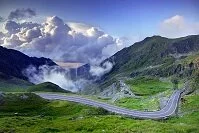Geography, Weather, & Wildlife of Romania
Geography

Carpathian Mountains
Romania is the largest country on the Balkan Peninsula, reaching from the Black Sea inland. Romania is bordered by Hungary (northwest), Serbia (southwest), Bulgaria (south), Ukraine (east and north), and Moldova (northeast).
Geographically, Romania is a fairly flat and level country, but has a number of hills and a stretch of mountains. From the north, stretching into the middle of the country, and to the west runs a narrow line of the Carpathian Mountains. For most of this stretch the mountains are more hills at elevations than towering peaks. The rest of the country is very flat and the Danube River flows along the country's southern border before flowing into the Black Sea on Romania's east coast. This low-lying land is very fertile and livable, but along the Black Sea is also very susceptible to flooding.
Weather

Danube River delta
Romania's seasons are very distinct, but there are significant geographical variations. Romania is fairly humid year round as rain is not unusual during the summers and snow, especially in the mountains, is not uncommon in the winters. However, the country doesn't receive as much rain as much of Western Europe and the precipitation amounts dwindle as you move east.
Winters (December-February) can be very cold and rarely get above freezing in the mountains, while the Danube Delta will rarely fall to the freezing point.